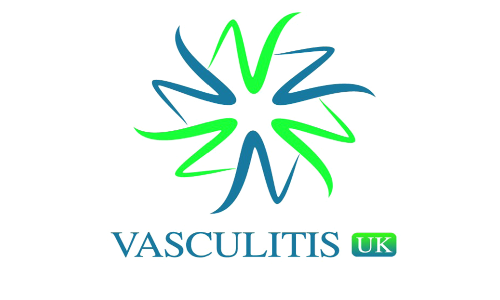Introduction
The European recommendations for the management of ANCA-associated vasculitis were updated and published in June 2016 (see the Annals for the Rheumatic Diseases website)
Shared decision-making between patients and their doctors is a central focus of newly updated recommendations. They have been produced by clinicians representing both the European League Against Rheumatism (EULAR) and European Renal Association – European Dialysis and Transplant Association (ERA-EDTA).
What do we know already?
When someone has ANCA-associated vasculitis (AAV), their immune system -which normally fights infection – mistakenly attacks their blood vessels and surrounding tissue. This can compromise the function of these tissues, leading to a whole range of signs and symptoms including: bleeding and crusting from the nose, cough and shortness of breath, tiredness, aching in muscles, loss or blurring of vision and double vision which may also be associated with eye pain, swollen, stiff, and painful joints, pain or numbness in arms and legs and confusion.
Immunosuppressive drugs can help stop this happening by reducing damage to the blood vessels and helping prevent irreversible damage and disability.
Immunosuppressive drugs are the main treatment for AAV, and there are many different types including:
- Older, standard types, which are manufactured chemically: cyclophosphamide, steroids, azathioprine, methotrexate and mycophenolate. Newer types, often called ‘biologics’. The main drug of this type used to treat AAV is rituximab.
- In certain situations giving patients blood proteins via a drip or even removing the immune proteins via a machine that ‘washes’the blood may be appropriate.
With so many options to consider, deciding on a treatment approach can be a challenge, particularly since research does not provide clear answers on which works best and is safest. To help with this, the European groups of both EULAR and ERA-EDTA convened a task force of doctors specialising in AAV, nurses and patient representatives to review the current research and provide guidance. They have now released their recommendations which are an update of those published in 2009.
Creation of the recommendations
The 21-member task force, assembled from 12 countries including continental Europe, United Kingdom, Ireland, and the United States. Systematic literature searches from January 2007 to February 2015 were made for items in the 2009 recommendations with an open-ended search period for newly identified items. A non-exhaustive list of items identified for updating included the importance of ANCA and biopsy in diagnosis and follow-up, disease staging at diagnosis, the choice of remission-induction and -maintenance therapies, and the drug choices for relapsing and refractory disease. Newly considered were the choice of immunosuppressive drugs and biologic agents (principally rituximab), and immunological monitoring. Patient education was identified as another priority.
What do the recommendations say?
The updated recommendations emphasise the importance of doctors, nurses and patients working together to find the best care approach, stressing that treatment must be based on shared decisions between the patient and their doctor. Other key principles are:
- Specialists who have a special interest and expertise in AAV should primarily care for people with AAV.
- Biopsy of an affected organ (most commonly the kidney) can be helpful in confirming a new diagnosis of AAV and in those patients having a relapse.
- The aim of the treatment should be remission.
- Doctors should monitor patients using structured clinical assessment and make use of validated tools to monitor for complications of AAV and also the drugs used to treat it.
- A combination of steroid and either cyclophosphamide or rituximab should be the first-line treatment for doctors and patients to consider for newly diagnosed organ or life-threatening AAV.
- Patients and doctors should use steroids (glucocorticoids) as part of patients’ initial treatment (along with immunosuppressive drugs) but these drugs should be reduced and stopped as soon as possible. If the first treatment approach doesn’t work well enough, patients should be referred to an expert centre for ongoing management and possible enrolment in clinical trials.
- For patients who relapse with either an organ or life-threatening disease, a combination of steroid and either cyclophosphamide or rituximab should be the first-line treatment doctors and patients consider.
- When a patient has been successfully treated for their initial disease or relapse then a period of treatment with remission-maintenance should occur. The drug choices include: azathioprine, rituximab, methotrexate and mycophenolate. The precise drug will depend both on the type of AAV you have and which drug was used to bring about remission in the first place.
- If a patient’s AAV is not active (in remission) then the immunosuppressive drugs including the steroids should be reduced. However treatment with remission-maintenance therapy should be continued for at least 24 months in those patients in stable remission (i.e. have not suffered relapses during that period). This is a decision that should be carefully considered by the patient and their doctor.
- When treatment needs to be adjusted, other things need to be taken into account, along with a patient’s disease activity and ANCA titre result, includeany other illnesses, possible side effects of current or previous treatment and the development of damage over time.
How reliable are the recommendations?
These recommendations are based on a thorough review of the current research and knowledge, as well as discussions among experts and patient representatives. They should provide reliable guidance on the best approach to treating AAV.
What does this mean for me?
If you have AAV, these recommendations should provide useful insight into what treatments you are likely to be offered and when. They also emphasise that as a patient, you should have a voice in your treatment. If you have any questions or concerns, be sure to speak with your specialist.
From: Yates M, Watts RA, Bajema IM, et al. EULAR and ERA-EDTA recommendations for the management of ANCA-associated vasculitis. Annals of the Rheumatic Diseases 2016 (doi:10.1136/annrheumdis-2016-209133).
